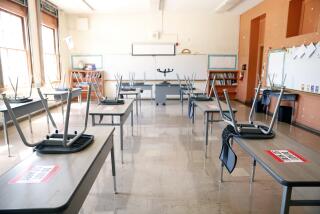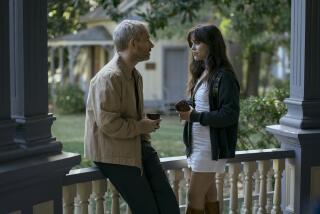Not Just for Kids: ‘Middle School: The Worst Years of My Life’
- Share via
Middle School
The Worst Years of My Life
James Patterson and Chris Tebbetts, illustrations by Laura Park
Little, Brown: 284 pp., $15.99, ages 12 and up
Middle school is an awkward other-world — a purgatorial pit stop between childhood and teendom that’s difficult to negotiate even for the most self-confident of kids, let alone an undersized boy without friends who’s bullied by a shaved-headed thug nicknamed Miller the Killer.
In James Patterson’s first book written specifically for middle-grade readers, the horrors are laid out with words and elaborated upon with pictures that chronicle the miseries of one Rafe Khatchadorian, an incoming sixth-grader at the institution he refers to as Hills Village Prison for Middle Schoolers.
Co-written by Chris Tebbetts, this fictional autobiography is a natural companion to Jeff Kinney’s “Diary of a Wimpy Kid” series, plumbing, as it does, the depths of tween angst in a self-deprecating confessional style that occasionally asks questions of the reader.
“Inside, what are you like?” Rafe asks toward the tail end of the first chapter of a book that’s framed as a bid for friendship. “Are you basically a pretty good, pretty decent person? Says who? Says you? Says your ‘rents? Says your sibs?”
After showing the readers a pen-and-ink drawing of himself sporting a bowl cut, polo shirt and backpack worn safely on both shoulders, he asks, “We still friends, or are you out of here? Hey — don’t go — all right?”
Readers will want to stick around. “Middle School” has a keen appreciation of kids’ insecurities and an even more astute understanding of what might propel boy readers through a book. Not only is Rafe’s plight relatable, so is the manner in which he expresses it. The lingo is casual and humorous, and as self-aware as one might expect from an 11-year-old. The book is well-stocked with pen-and-ink doodlings by cartoonist Laura Park that mimic the look of notebook creations by actual sixth-graders. The longest stretch of reading without some sort of graphic element is two pages.
Rafe lives with his little sister, Georgia, his overworked waitress mom and a boorish stepfather-to-be whose only value is warming the couch. So when Rafe’s reaction to an assembly presentation of the school’s code of conduct is the goal of breaking every rule in the book, no one is there to offer a smarter path. What starts with the pulling of a fire alarm escalates to the destruction of school property and detention with Ms. Ruthless Donatello, a.k.a. the Dragon Lady.
But Rafe is a kindhearted mischief maker whose rule-breaking is conducted with a no-hurt mandate. He doesn’t understand what is compelling him and neither does the reader until the book’s end, which concludes happily and, more important, without blaming the protagonist, though it does hold him accountable for his actions.
Many of the characters in “Middle School” are stereotypes — the militaristic gym teacher reliving his glory days, the trio of lunch ladies concocting toxic meatloaf and other inedible fare, the blond girl class-representative-to-be who inspires a crush — but they’re played to great comedic effect in Park’s illustrations. On a two-page spread detailing gym class, Coach Lattimore holds a clipboard under his hairy arm that reads “Pain,” while a boy, lying nearby in the grass, actually lives it. He’s broken in half.
“Middle School” does a wonderful job of channeling the anxiety, and (il)logic, of the middle-grade mind. “Middle School” is a perfectly pitched novel exploring an important and under-covered topic: the unhealthy ways in which disempowered kids express themselves to obtain some sort of control over situations in which they find themselves helpless.
More to Read
The biggest entertainment stories
Get our big stories about Hollywood, film, television, music, arts, culture and more right in your inbox as soon as they publish.
You may occasionally receive promotional content from the Los Angeles Times.










